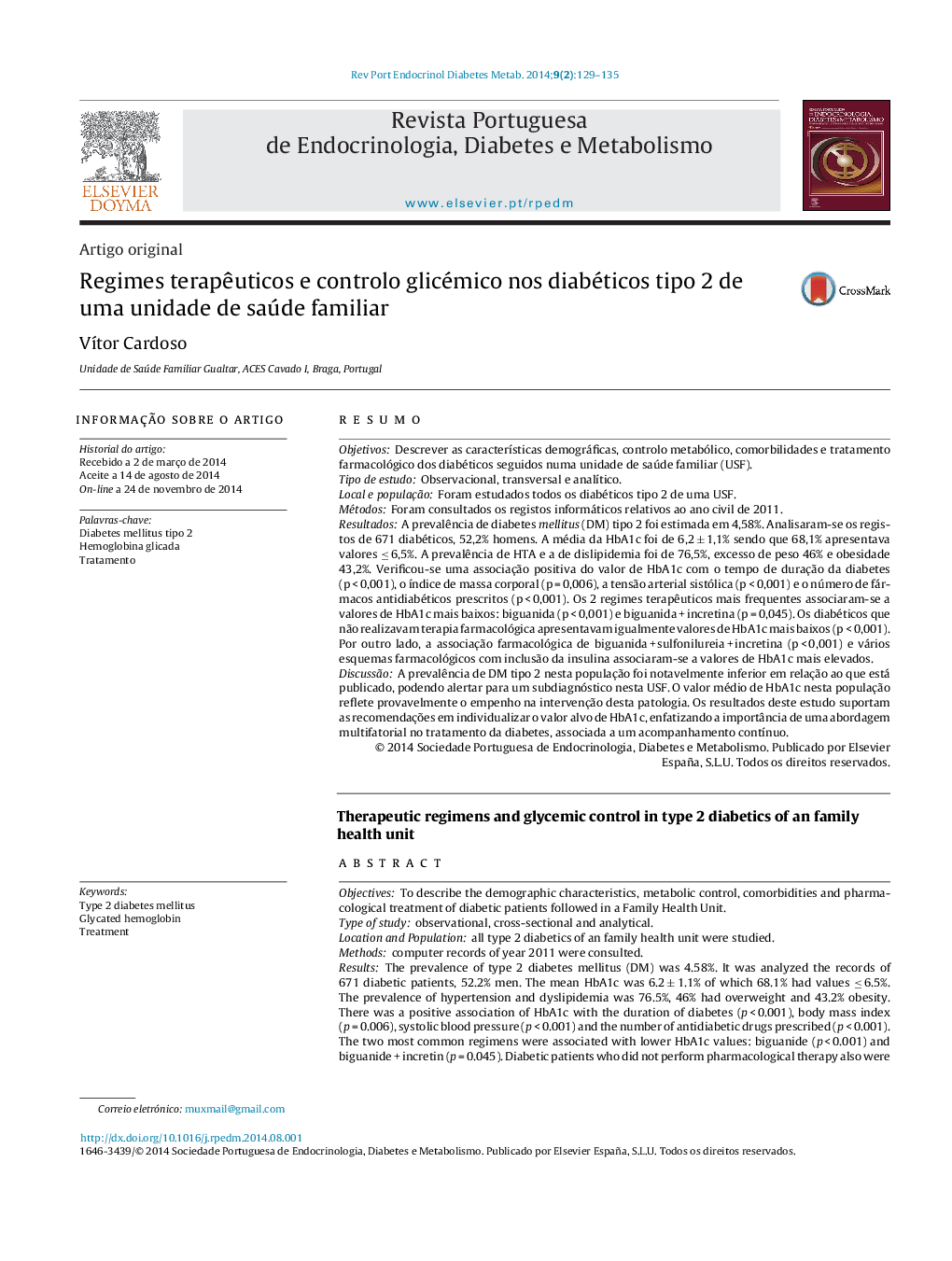| Article ID | Journal | Published Year | Pages | File Type |
|---|---|---|---|---|
| 3278362 | Revista Portuguesa de Endocrinologia, Diabetes e Metabolismo | 2014 | 7 Pages |
ResumoObjetivosDescrever as características demográficas, controlo metabólico, comorbilidades e tratamento farmacológico dos diabéticos seguidos numa unidade de saúde familiar (USF).Tipo de estudoObservacional, transversal e analítico.Local e populaçãoForam estudados todos os diabéticos tipo 2 de uma USF.MétodosForam consultados os registos informáticos relativos ao ano civil de 2011.ResultadosA prevalência de diabetes mellitus (DM) tipo 2 foi estimada em 4,58%. Analisaram‐se os registos de 671 diabéticos, 52,2% homens. A média da HbA1c foi de 6,2 ± 1,1% sendo que 68,1% apresentava valores ≤ 6,5%. A prevalência de HTA e a de dislipidemia foi de 76,5%, excesso de peso 46% e obesidade 43,2%. Verificou‐se uma associação positiva do valor de HbA1c com o tempo de duração da diabetes (p < 0,001), o índice de massa corporal (p = 0,006), a tensão arterial sistólica (p < 0,001) e o número de fármacos antidiabéticos prescritos (p < 0,001). Os 2 regimes terapêuticos mais frequentes associaram‐se a valores de HbA1c mais baixos: biguanida (p < 0,001) e biguanida + incretina (p = 0,045). Os diabéticos que não realizavam terapia farmacológica apresentavam igualmente valores de HbA1c mais baixos (p < 0,001). Por outro lado, a associação farmacológica de biguanida + sulfonilureia + incretina (p < 0,001) e vários esquemas farmacológicos com inclusão da insulina associaram‐se a valores de HbA1c mais elevados.DiscussãoA prevalência de DM tipo 2 nesta população foi notavelmente inferior em relação ao que está publicado, podendo alertar para um subdiagnóstico nesta USF. O valor médio de HbA1c nesta população reflete provavelmente o empenho na intervenção desta patologia. Os resultados deste estudo suportam as recomendações em individualizar o valor alvo de HbA1c, enfatizando a importância de uma abordagem multifatorial no tratamento da diabetes, associada a um acompanhamento contínuo.
ObjectivesTo describe the demographic characteristics, metabolic control, comorbidities and pharmacological treatment of diabetic patients followed in a Family Health Unit.Type of studyobservational, cross‐sectional and analytical.Location and Populationall type 2 diabetics of an family health unit were studied.Methodscomputer records of year 2011 were consulted.ResultsThe prevalence of type 2 diabetes mellitus (DM) was 4.58%. It was analyzed the records of 671 diabetic patients, 52.2% men. The mean HbA1c was 6.2 ± 1.1% of which 68.1% had values ≤ 6.5%. The prevalence of hypertension and dyslipidemia was 76.5%, 46% had overweight and 43.2% obesity. There was a positive association of HbA1c with the duration of diabetes (p < 0.001), body mass index (p = 0.006), systolic blood pressure (p < 0.001) and the number of antidiabetic drugs prescribed (p < 0.001). The two most common regimens were associated with lower HbA1c values: biguanide (p < 0.001) and biguanide + incretin (p = 0.045). Diabetic patients who did not perform pharmacological therapy also were associated with lower HbA1c values (p < 0.001). On the other hand, the pharmacological association sulfonylurea + biguanide + incretin (p < 0.001) and multiple drug regimens with inclusion of insulin were associated with higher values of HbA1c.DiscussionThe prevalence of type 2 DM in this population was significantly lower compared to what is published and can alert to an underdiagnosis in this health unit. The mean HbA1c in this population probably reflects the commitment on the intervention of this pathology. The results of this study support the recommendations to individualize the target value of HbA1c, emphasizing the importance of a multifactorial approach in the treatment of diabetes, associated with a continuous monitoring.
